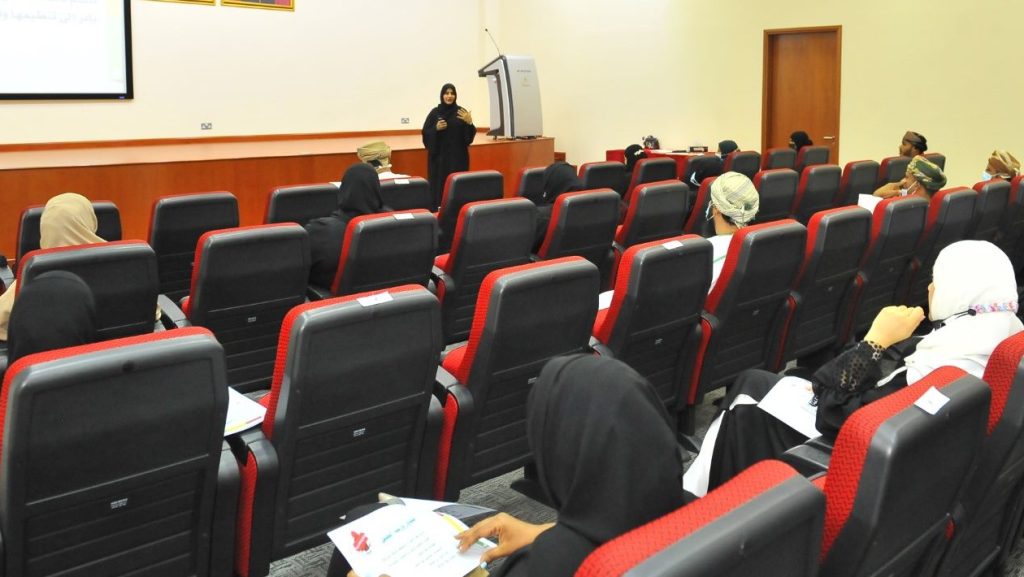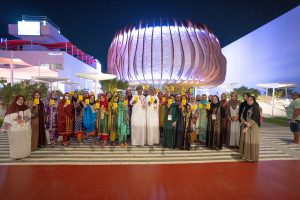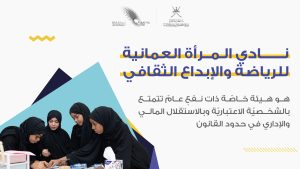The General Directorate of Sports Activities at the Ministry of Culture, Sports, and Youth continued to workshops presented by Ministry employees to an initiative launched by the Directorate and in cooperation with the Department of Human Resources Development to introduce employees to their colleagues and allow them to showcase their skills. On Monday morning, the workshop was held on sign language in the meeting room of the Ministry’s General Diwan in Rewi by Ahlam Bint Ali Al-Hinaiah, a sign language translator at Al-Amal Club.
.
This workshop addressed six axes, including the history of sign language, its uses and advantages, the ABC’s of sign language, and the reasons for its adoption. Additionally, Ahlam Al-Hana’a discussed the components of sign language and the basics of dealing with the deaf. Moreover, its use in our lives. At the end of the workshop give some advice as well as a few tips that must be followed while using sign language.
.
Sign language is defined as visual movement symbols that are used in a specific order to represent ideas. In addition, it depends mainly on the use of hands to express ideas. It is the main language for communicating with the deaf, and many words do not have equivalents in sign language.
.
Sign Language’s History
Ahlam Al-Hana’a explored the history of sign language, as it was discovered spontaneously among the deaf and was always local, so it differed from country to country. Sign language has increased since it became a recognized language in many countries, and is considered the natural mother tongue for them because it is linked to strong psychological dimensions, and because it can express easily the needs the deaf have. There is a misconception that all sign languages are similar, or even international, which isn’t true. The World Federation of the Deaf released a statement confirming ((there is no international sign language)) and that sign languages are distinct from one another like spoken languages.
.
The Reasons for Using AFP
The workshop addressed the reasons for using AFP, including the use of one hand to represent the alphabet, Fingerspelling as a supportive method for sign language, and rarely used separately. In addition, It is used to introduce new concepts (such as globalization and democracy, which have no signs, so we use fingerspelling to clarify them). There are names without signs recognized by the deaf community, as well as the alphabet by using the fingers: each letter of the twenty-eight letters of the alphabet is recognized for only one motion, for example, the letter A alone is recognized, and so on. The finger alphabet method is considered one of the most effective ways of communicating with the Deaf, since it is part of the overall communication process, especially concerning words, names of people, or addresses without agreed-upon signs, which Graham emphasizes by saying: “Fingerspelling is the most convenient way to read and the quickest way to bring words to the deaf person’s attention.”
.
A sign language component
As Al-Hana’a explained that sign language is divided into four main parts: Firstly, the movements of the hands (fingers to clarify numbers and letters). Secondly, the facial expressions (looks) convey feelings and tendencies. Thirdly, the movements of the lips to read lips. It is an advanced stage of observation where the deaf reads words directly from the lips. Finally the movement of the body as moving signs on the shoulders or the top and sides of the head or chest and abdomen to clarify desires and meanings.
.
In the conclusion, Al-Hana’a provided tips when using sign language, perhaps the most important of which is that it is important to use the right hand to achieve the required signs for words as the word (AB). If the word requires both hands, then both hands should be used and the right hand is the central point, just like the word (tawaf), whereas the left-hand remains fixed and the right finger circumambulates around the left hand. In addition, when using the indicative alphabet (the letters of the alphabet), the palm is in front of the deaf, such as (B), and when using numbers, the back of the hand is in front of the deaf, such as (4).










